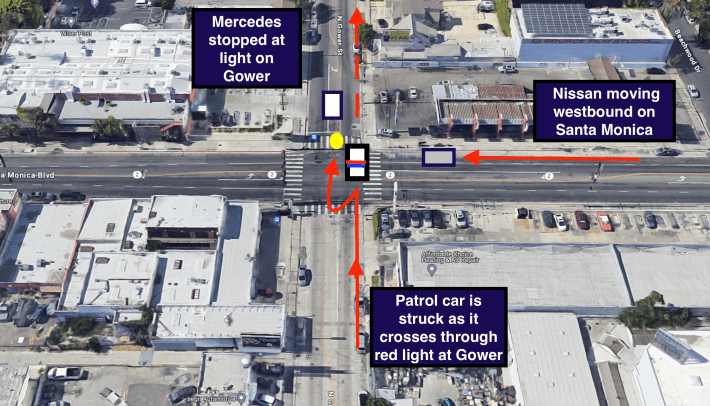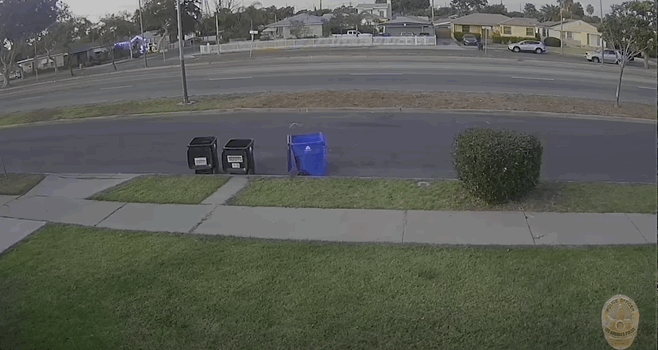In a statement posted to the LAPD website today, the department acknowledged that the multi-vehicle crash that injured six and killed a pedestrian in Hollywood occurred when officers - who the department says turned on their lights and sirens before moving into the intersection - attempted to cross Santa Monica Blvd. against the red light.
Per the statement, a Hollywood Patrol Unit traveling northbound on Gower at around 3:50 p.m. on April 29 first stopped at the red light at Santa Monica and then "activated the vehicle’s emergency lights and proceeded through the intersection when traffic appeared clear." As they did so, a westbound Nissan crashed into the right rear of the patrol vehicle, sending it into a pedestrian that was crossing the street in the marked crosswalk. The momentum then sent both the pedestrian and police vehicle crashing toward a Mercedes stopped at the light on Gower.
The pedestrian was knocked under the patrol vehicle at some point and later died from their injuries. The name of the pedestrian has not yet been released.

The statement does not explain why officers turned on their lights to cross a busy street on a red or why they did so at the same moment a pedestrian that had the right of way was crossing through the opposite crosswalk. LAPD responded to Streetsblog's questions for more information by saying the incident was still under investigation.
Of note, the official details of the incident don't quite match KTLA's post-crash reporting. In a segment broadcast the evening of the 29th, the driver of the Mercedes told Carlos Saucedo that LAPD had been "honking" to clear the intersection (lights and sirens weren't mentioned) and that other cars around the intersection had stopped (suggesting the intersection was busier than the department's statement indicates).
Also of note, Captain Kelly Muñiz, Commanding Officer of Media Relations, confirmed the officers were not involved in a pursuit.
If Muñiz knew officers were not involved in a pursuit, then it is more than likely she had been advised that they had also crossed against the light. But she does not divulge that information to the press. Instead, she leaves the cause of the crash ambiguous and says that "what other activity [the officers] were involved in still has not been determined at this time."
The official Public Information twitter account, where LAPD posts the first iteration of its written public statements, also opted not to mention the officers' actions prior to the crash.
Instead, the PIO's vague tweets implied a reckless westbound driver had somehow veered into a patrol vehicle that had already cleared the intersection while also declaring that the "exact cause of the collision" remained unknown.
When asked for details about the incident at the Police Commission meeting the following day, Interim Chief Dominic Choi declined to comment and said he would have more to report at the next meeting.
This is an awful incident that left one dead and injured six. But it's also a signaled intersection... Did one of the vehicles run the light? (Image from citizen app) https://t.co/mDab7EuXLL https://t.co/4qjq1CWvvc pic.twitter.com/X1ZVSLUQF2
— sahra (@sahrasulaiman) April 30, 2024
It's a striking level of evasiveness, and one that stands in sharp contrast to the way "officer-involved shooting" (OIS) incidents are typically reported. In those cases, the department's first round of statements generally ascribe clear blame to subjects and offer heightened descriptions of the threat those subjects posed. Then, once the initial news cycle has passed, those descriptions are often quietly walked back or clarified.
But it's also not the first time LAPD has not been forthcoming about what caused a crash involving a patrol vehicle.
When a cruiser's apparent solo crash nearly crushed a pedestrian on a Normandie sidewalk last November, the department's statements were wildly inconsistent. ABC7 reported the department said the officers might have hit a nail, deflating a tire and causing them to lose control. KCAL reported they had been told the officers had lost control after being involved in a crash. And the L.A. Times reported the driver simply felt the front wheel suddenly seize up. Months later, it remains unclear which, if any, of these stories are true.
LAPD was similarly evasive after the horrific December 8 crash that killed 26-year-old Luis Espinoza.
In that case, an officer from the Community Safety Partnership Bureau smashed into Espinoza as she approached an intersection at high rate of speed. The impact tossed Espinoza up onto the windshield and then flung him forward onto the pavement, where he skidded approximately 100 feet along Century Blvd. before coming to rest.

Very early on in that investigation, then-Chief Michel Moore went on record to express grave concerns about the officer's driving and indicated the case would be presented to the District Attorney "for filing considerations" when the investigation was complete. But LAPD's official written statement still indirectly blamed Espinoza for not having the right of way and for being "outside the marked crosswalk" when he was struck. It also omitted mention of the officer's improper use of "Code 3" (emergency lights and sirens) or the fact that she had turned on her lights and sirens to run an errand; that news only came courtesy of reporting by the L.A. Times.
The critical incident briefing released a month later somehow provided even less transparency. It described Espinoza as “running southbound on Century Boulevard” (language that suggested he was aimlessly running amok instead of crossing the street) while avoiding any mention of the officer's speed, how many red lights she had run, how many intersections she had failed to clear properly, or why she had chosen to endanger South L.A. road users, among many other things.
Nearly five months on, LAPD still has not named the officer that killed Espinoza, elaborated on the errand she was allegedly running, or handed the case over to the D.A.

It will likely be a few more weeks before a critical incident briefing is provided with additional information about how the Hollywood crash unfolded.
Whether that briefing will also include information about why it unfolded the way it did is unfortunately less certain.
This is a developing story.
UPDATE May 29, 2024: LAPD has released the critical incident briefing video. Please note: it is graphic. The briefing confirms the officers ran the red light.
A close watch of the video makes clear the officers turned off their lights/sirens before they had fully cleared the intersection and before the driver of the Nissan would have been able to see them, resulting in the crash. No explanation for this has been given.
just noticed rewatching this that they shut their lights/sirens off before they finished clearing the intersection. incredible.https://t.co/ZbdKAOqLbL
— sahra (@sahrasulaiman) May 30, 2024







